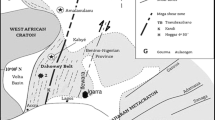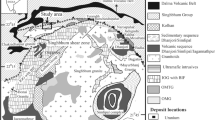Abstract
Shillong basin, one of the Purana basins of the Indian peninsula is situated in the central and eastern parts of the Shillong plateau of NE India. Metasedimentary and metavolcanic rocks of the basin are of Mesoproterozoic age and lithostratigraphically belong to Shillong Group (erstwhile Shillong series) comprising Lower Metapelitic Formation (LMF) and Upper Quartzitic Formation (UQF). A long, persistent, faulted and tectonically attenuated conglomerate known as Nongkhya-Sumer-Mawmaram-conglomerate separates these two formations. In the present work, quantitative strain analyses of the pebbles of Sumer, Nongkhya and Mawmaram conglomerates of Ri-Bhoi and West Khasi Hills districts of Meghalaya are carried out using manual and computerized programmes. Eight different techniques for intrapebble, interpebble and bulk rock strain estimation are applied and results are compared systematically. Sumer and Mawmaram conglomerates bear the testimony of broadly flattening type of deformation (0 < k < 1) while Nongkhya conglomerate shows constriction type (1 < k < α). The change in strain ellipsoid shape from Nongkhya to Mawmaram area is accompanied by a change of fabric from S < L to L < S tectonites. Affinity of rotational strain is more in Nongkhya conglomerate as compared to Sumer and Mawmaram conglomerates. The compactness of pebbles is high in case of Nongkhya conglomerate and low to moderate in Sumer and Mawmaram conglomerates indicating high strain in Nongkhya conglomerate (northeastern part of Shillong basin) relative to Sumer and Mawmaram conglomerates (southwestern part of Shillong basin). Thus strain magnitude increases from SW to NE direction of the Shillong basin.
The tectonostratigraphic status of these conglomerates suggest that the Sumer and Mawmaram conglomerates were initially a part of one conglomerate horizon of interformation type between LMF and UQF of the Shillong Group. With progressive deformation, the northeastern part of the Sumer conglomerate suffered tectonic attenuation and separation and eventually thrusted over the Basement Gneissic Group (BGG) as a tectonic mélange. This sector of the conglomerate is known as Nongkhya conglomerate. The tectonic configuration of the Nongkhya conglomerate is the effect of right and left lateral strike slip movement of Sumer conglomerate at Sumer and Adabasti points, respectively. This is a positive signature of post D 3 deformation on the Sumer conglomerate. The regional sigmoidal pattern of the interformational conglomerate broadly correlate with the Tyrsad-Barapani Shear Zone (TBSZ) of sinistral nature.
Similar content being viewed by others
References
Ahmed M 1971 Geology of the Precambrian rocks of the Barapani area, Khasi and Jaintia Hills, Assam. D.Phil. Thesis, Univ. of Gauhati, unpublished.
Ahmed M 1981 Stratigraphic Class of Shillong Group, Khasi Hills, Meghalaya; J. Mines, Metals and Fuels. Sept.–Oct., pp. 295–297.
Barooah B C and Goswami I D 1972 Precambrian stratigraphy of the Assam plateau; J. Mines, Metals and Fuel 20 368–373.
Barooah B C 1976 Tectonic pattern of the Precambrian rocks around Tyrsad, Meghalaya; Geol. Surv. India Misc. Publ. 23(2) 485–495.
Bhattcharjee C C and Rahman S 1985 Structure and lithostratigraphay of the Shillong Group of rocks of East Khasi Hills of Meghalaya; Bull. Geol. Min. Met. Soc. India 53 90–99.
Bhattacharyya B P and Ray Barman T 1998 Precambrian geology in Northeastern India: A perception of contribution during Pre and Post Independence Era; M.S. Krishnan Centenary Commomorative, National Seminar, 12 November 1998, Calcutta, 11–12.
Bidyananda M and Deomurari D 2007 Geochronological constraints on the evolution of Meghalaya massif, northeastern India: An ion microprobe study; Curr. Sci. 93(11) 1620–1623.
Burns K L and Spry A H 1969 Analysis of shape of deformed pebbles; Tectonophys. 7 177–196.
Chatterjee N, Mazumdar A C, Bhattacharya A and Saikia R R 2006 Mesoproterozoic granulites of the Shillong-Meghalaya Plateau: Evidence of westward continuation of the Prydze Bay Pan-African suture into Northeastern India; Precamb. Res. 125 1–26.
Crawford A R 1969 India, Ceylon and Pakistan: New age data and comparison with Australia; Nature 223 80–84.
Devi N R and Sarma K P 2006 Tectonostratigraphic study of conglomerates of Shillong Basin of Meghalaya, India; J. Geol. Soc. India 68 1100–1108.
Devi N R, Devi N and Sarma K P 2006 A simple algebraic method to estimate strain ratio of Mawmaram conglomerate of Shillong Basin of Meghalaya, NE India; Proc. 51st Tech. Session, Ass. Sc. Soc. 7 197–207.
Devi N R, Kakati P, Borah P, Konwar P and Sarma K P 2009 Microstructural Architecture of Mesoproterozoic Lower Metapelitic Formation of Shillong Basin, Meghalaya, India; Earth Syst. Sci. Platinum Jubilee volume of V K Verma, 324–341.
Dunnet D 1969 A technique of finite strain analysis using elliptical particles; Tectonophys. 7(2) 117–136.
Dunnet D and Siddan AWB 1971 Non random sedimentary fabrics and their modification by strain; Tectonophys. 12 307–325.
Eremenco N A, Negi B S, Nasianov M V, Seregin A M, Despande B G, Sengupta S N, Talukdar S N, Sastri V V, Sokaluv I P, Pavbukov A T, Datta A K and Raju A T R 1969 Tectonic map of India — Principles of preparation; Bull. ONGC 6(1) 1–111.
Flinn D 1962 On folding during three-dimensional progressive deformation; Geol. Soc. London. Quart. J. 118 385–433.
Fry N 1978 Construction and computation of 3-D progressive deformation; J. Geol. Soc. London 135 291–305.
Fry N 1979 Random point distributions and strain measurement in rocks; Tectonophys. 60 89–105.
Geological Survey of India 1972 Code of stratigraphic nomenclature of India; Misc. Publ. 20 28pp.
Ghosh S K 1993 Structural Geology: Fundamentals and modern developments (Oxford: Pergamon Press) 598 p.
Ghosh S, Chakravorty S, Bhalla J K, Paul D K, Sarkar A, Bishuri P K and Gupta S N 1991 Geochronology and geochemistry of granite plutons from East K. Hills, Meghalaya; J. Geol. Soc. India 37 331–342.
Ghosh S, Chakraborty S, Bhalla J K, Paul D K, Sarkar A, Bishui P K and Gupta S N 1994 New Rb-Sr isotopic ages and geochemistry of granitoids from Meghalaya and their significance in middle to late Proterozoic crustal evolution; Indian Minerals 48(1&2) 33–44.
Goswami T K and Sarma K P 2001 Comparison of strain rate in Sumer and Nongkhya conglomerate of Meghalaya, India; Bull. Pure Appl. Sci. 20F(1–2) 71–81.
Hanna S S and Fry N 1979 A comparison of methods of strain determination in rocks from SW Dyfed (Penbrokeshire) and adjacent area; Tectonophys. 5 315–319.
Harijan N, Sen A K, Sarkar S, Das J D and Kanungo D P 2003 Geomorphotectonics around the Sung valley carbonatite complex, Shillong plateau, NE India: Remote sensing and GIS approach; J. Geol. Soc. India 62(1) 103–109.
Holcombe R J 1999 GeoFryplots 3.0, Strain measurement using the point to point method. University of Queensland, Australia.
Hossack J R 1968 Pebble deformation and thrusting in the Bygdin area; Tectonophys. 5 315–319.
Hsu T C 1966 The characteristics of coaxial and noncoaxial strain paths; J. Strain Analysis 1 216–222.
Johnson S J and Alam A M N 1991 Sedimentation and tectonics of the Sylhet Trap, Bangladesh; Geol. Soc. Am. Bull. 103 1513–1527.
Mazumder S K 1976 A summary of the Precambrian geology of the Khasi Hills, Meghalaya; Geol. Soc. India Misc. Publ. 23(2) 311–334.
Mazumder S K 1986 The Precambrian framework of part of the Khasi Hills, Meghalaya; GSI Record. 117(2) 1–59.
Medlicott H B 1869 Geological sketch of the Shillong Plateau in North-Eastern Bengal; Geol. Soc. India Memoir VII(I) 197–207.
Mitra S K 1998a Polydeformation of rocks of the Shillong Group around Sohiong, Khasi Hills; Ind. J. Geol. 70(1&2) 123–131.
Mitra S K 1998b Structure, sulphide mineralisation and age of the Shillong Group of rocks, Meghalaya; S K Krishnan Centinary Commemorative National Seminar. 1–2 November, 1998, Calcutta, 118–119 (Abstract).
Nadai A 1963 Theory of flow and fractures of solids, Engineering Societies Monographs (New York, NY: McGraw Hill) 2 227–240.
Nandy D R 2001 Geodynamics of NE India and the adjoining region; ACB publication, 209 p.
Patel R C and Jain A K 1994 Strain patterns of the Shergol Ophiolite Melange of the Indus Suture Zone, Ladakh; J. Himalayan Geology 5(2) 133–145.
Ramsay J G 1967 Folding and fracturing of rocks (New York: McGrow Hills) 568 p.
Ramsay J G and Wood D S 1973 The geometric effects of volume change during deformation processes; Tectonophys. 13 163–271.
Ramesh D S, Ravi Kumar, Uma Devi and Raju P S 2005 Moho geometry and upper mantle images of NE India; Geophys. Res. Lett. 32 L14301–04.
Roday P P 2001 A to Z of structural geology and tectonics: A CD ROM Companion.
Roday P P 2003 Windows 32-Bit Platform Software for plots to display the finite strain data; J. Geol. Soc. India 62 36–42.
Sarma K P and Dey Tulika 1996 Re-look on Shillong Plateau; Bull. Pure Appl. Sci. 15F(2) 51–54.
Sarma K P, Bharali T K and Chowdhary P K 1998 Rotation of micro-structural fabric in the Barapani shear zone, Meghalaya; Proc. Reg. Sem. Dev. Geol. Res. in NE India, Gauhati University, 57–67.
Sarma K P 2001 Basement-cover relationship of gneisses with the low grade Shillong Group of rocks of RiBhoi District, Meghalaya; DST project completion report, 74p.
Sarma K P, Goswami T K and Ahmed M 2001a Intrapebble strain rate in Sumer and Nongkhya conglomerate of Meghalaya, India; J. Geosci. 5&6 5–13.
Sarma K P, Ahmed M and Goswami T K 2001b Strain analysis of the Nongkhya conglomerate; Indian Minerals 55(3&4) 227–236.
Sarma K P, Devi N R, Agnes L P, Narry I L, Vicky D and Saralin W 2003 Microstructural behaviour of deformed metapelites of Shillong basin, Meghalaya; J. Geosci. 7&8 14–25.
Sarma K P and Devi N R 2006 Structure and tectonics of the Shillong Plateau, NE India; J. Geosci. 11 1–16.
Shimamoto T and Ikeda Y 1976 A simple algebraic method for strain estimation from deformed ellipsoidal objects. 1. Basic Theory; Tectonophys. 36 315–337.
Stephanson O and Johnson K 1976 Granite diapirism in the Rum Jungle area, northern Australia; Precamb. Res. 3 159–185.
Toriumi M, Masui M and Mori K 1988 Strain in metacherts as determined from deformed shapes of radiolaria and Fry’s method; Tectonophys. 145 157–161.
Twiss R J and Moore E M 1992 Structural Geology; W H Freeman and Company, 629 p.
Zingg Th 1935 Beitrage Zur Schotteranatyse; Min. Petrog. Mitt. Schweiz. 15 35–140.
Author information
Authors and Affiliations
Corresponding author
Rights and permissions
About this article
Cite this article
Devi, N.R., Sarma, K.P. Strain analysis and stratigraphic status of Nongkhya, Sumer and Mawmaram conglomerates of Shillong basin, Meghalaya, India. J Earth Syst Sci 119, 161–174 (2010). https://doi.org/10.1007/s12040-010-0009-6
Received:
Revised:
Accepted:
Published:
Issue Date:
DOI: https://doi.org/10.1007/s12040-010-0009-6




